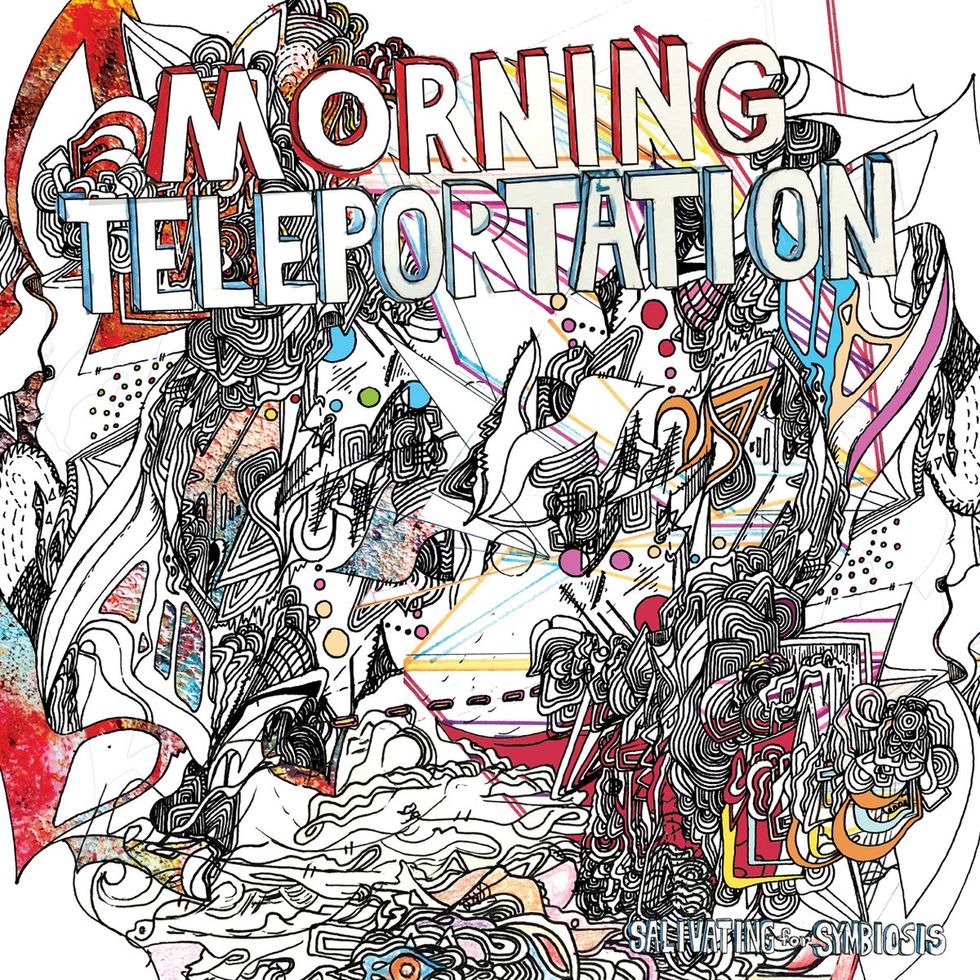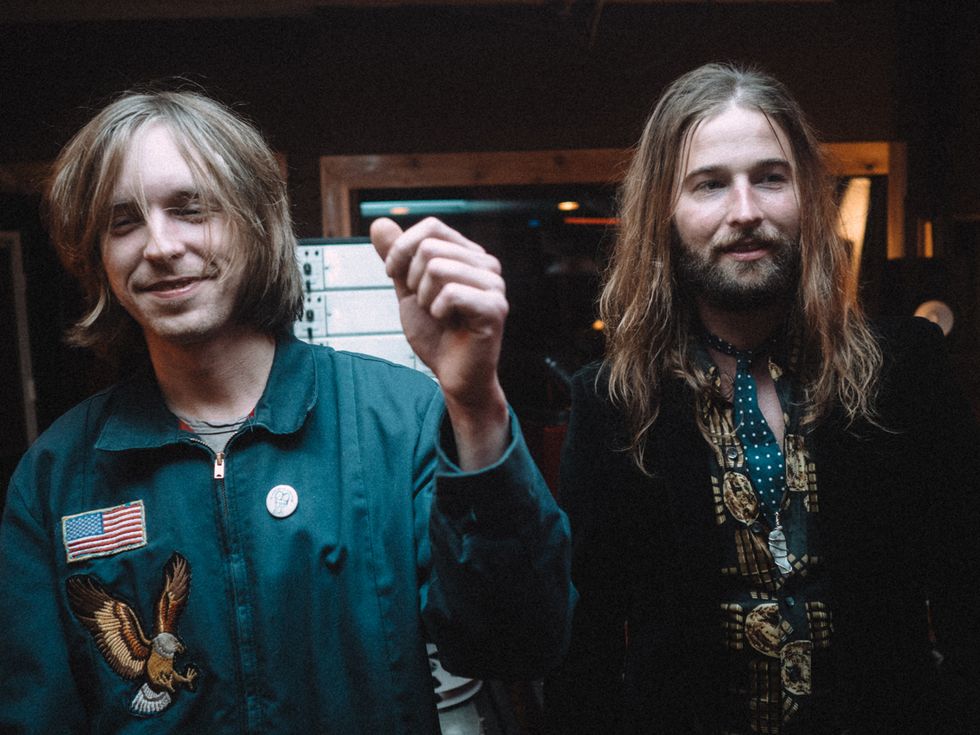It’s tricky to describe Morning Teleportation. Part indie, part progressive, and part psychedelic, the band hails from Bowling Green, Kentucky, yet Portland, Oregon, has been ground zero for much of its creative output. Though this year marks the release of just their second album, Salivating for Symbiosis, Morning Teleportation has shared stages with high-profile acts the group counts as friends. And while there are several core members, who is actually “in” Morning Teleportation at any given moment seems to be more about who’s available to hang out and write songs. Even with this cavalcade of seeming contradictions, Morning Teleportation excels at funneling all this creative inspiration and input into music that is simultaneously challenging, infectious, whimsical, and unhinged.
The band emerged when fellow Bowling Green natives Travis Goodwin (keyboards), Tres Coker (drums), and Paul Wilkerson (bass) collided with singer/guitarist/songwriter Tiger Merritt. Though birthed in the same town as their good friends Cage the Elephant, Morning Teleportation has also been welcomed into a scene of notable Northwest-based indie artists, including Death Cab for Cutie and Modest Mouse. In fact, Modest Mouse frontman Isaac Brock produced Morning Teleportation’s debut album, 2011’s Expanding Anyway.
After touring relentlessly with the Flaming Lips and Primus to promote Expanding Anyway, and then dealing with several lineup changes, the band needed a good long break. A natural nomad, Merritt went back on the road to find inspiration writing music with friends and colleagues around the United States, and these travels inspired many of the songs that would become Salivating for Symbiosis. The album’s opening track, “Rise and Fall,” delivers echoes of the Northwest folk, rock, and indie bands Morning Teleportation consider friends and peers. And perhaps that should be no surprise, given the album was recorded at Ice Cream Party studios in Portland. But the musical performances by members of Cage the Elephant and contributions by both current and former members of Morning Teleportation allow Salivating for Symbiosis to strike out on its own path of jarring dynamic shifts, fuzzed-out guitar solos, and dramatic changes in musical direction.
sound like something.”
Much of the creative energy that makes up Morning Teleportation can be directly attributed to the band’s frontman. Merritt is a unique blend of natural talent, free-wheeling spirit, and relentless diligence. In conversation, he comes off as a laid-back personality who would never rush a project. But dig a little deeper, and you’ll find an artist who is constantly on the move and isn’t happy unless he’s crafting new material with his heavyweight musician friends. When we caught up with Merritt, he was fresh off the band’s latest tour with Modest Mouse and already back to work building a studio and demoing new songs. Here he discusses his nonstop need to create, the tools he uses, and why his is a life on the road.
What initially drew you to music?
Oh, jeez. I guess my dad got me into music growing up. He would always mess with quadraphonic reel-to-reel tape machines, and he used to collect a lot of quadraphonic records. [ Editor’s note: Quadrophonic recordings were developed in the 1970s for playback on a surround-sound-like system with four speakers in a square arrangement. ] I also played saxophone in school a bit. Listening to music in high school—Built to Spill, Modest Mouse, and stuff like that—got me into playing. That and jamming with friends. Once I started playing guitar, I just figured that was probably what I was going to do somehow, someway.
With such a diverse musical upbringing, it’s no wonder Morning Teleportation sounds so wide ranging.
Yeah. We try not to take the same approach each time when we’re working on something. We follow whatever the idea is and wherever it goes.
It often goes to some incredibly progressive places—lots of dramatic shifts and a wide use of dynamics. Where does that inspiration come from?
I don’t know. Maybe Yes or [Chicago math-rock quartet] Ghosts and Vodka? I just like abrupt changes. You know how your brain darts around to different subjects and different things? It’s like that. I don’t know how to explain it. I just like the motion of it.

Jeremy Sherrer produced Salivating for Symbiosis, Morning Teleportation’s second album. “He works so hard—man, it’s crazy,” says the band’s cofounder Tiger Merritt. “He and I were basically living in the studio making this record.”
What’s the band’s typical writing process like, if there is such a thing?
If I write a song and take it to the band, it’s like, “Here’s this idea, and we can change it around, move it around, and make it something different.” It can start with anything. Maybe it’s a drum machine. Maybe it’s a drum beat or a bass line. I also like collaborating with a buddy and hashing up an idea. I always like using those little 4-track tape machines. They are really fun to get ideas down on. Sometimes that stuff ends up in the recordings, as well. If I’m writing and an idea stays in my head for a while, or I end up playing it quite a bit, it’ll probably be turned into something.
Do you handle all the songwriting or do the other guys in the band bring in complete songs?
Everyone will bring in riffs and ideas and we’ll work together to figure them out.
But it wasn’t only the core members of Morning Teleportation who worked on Salivating for Symbiosis. You had a lot of help from some good friends. Who else is featured on this album?
Paul [Wilkerson, the band’s original bassist] wrote on this one, as well as a lot of people who’ve been in the touring band over the past few years. Paul is an original—I love writing with him. This album was cool because we worked on it over a long period of time. So I was able to write with friends around the country, like our homies we’ve toured with and who’ve played in the band before. I mean, Nick [Bockrath, Cage the Elephant] was playing bass with us for a while too, and he wrote with us on this one.
With so much collaboration, do you see the band as more of a collective?
Well, recently it’s been Travis [Goodwin], Joe [Jones], and me on the last tour. But we’ve had such a good community of friends who have collaborated throughout the years that I look at it like … whoever is down to play and be a part of it.
Tiger Merritt digs into his No. 1 axe, a 2003 Fender Telecaster Highway One retrofitted with Lollar pickups. “That’s my favorite,” he says, “and it’s one of the first guitars I ever had, too.” Photo by Kyle Cooper
After the first full album, Morning Teleportation generated quite a bit of buzz. You were playing on bills with the likes of Modest Mouse and Cage the Elephant. And now this album comes around, and you have a lot of these guys collaborating with you. How did that come to be?
For a little while there, I was just kind of roaming. We’d go on tour and I’d just want to keep it going. So I kept traveling and wound up hanging out with these buddies. We’ve just been friends with those guys for years. Paul and Travis, they all grew up together in Bowling Green. As far as Daniel [Tichenor] and Nick, I mean, we’d all be hanging out anyway. Daniel was playing with Cage the Elephant in Portland while I was at a studio out there. They came in to say hi, and I was like, “You want to lay down some bass or something?” We just cruised back to the studio and put down some bass on “Calm Is Intention Devouring Its Frailty.”
Why the long break between Expanding Anyway and Salivating for Symbiosis?
We just kept going on the road and then became kind of toured out. We went through a lot of changes. I was pretty nomadic for a while, going back and forth between Portland, Kentucky, and Chicago. The album just took that long, I don’t know exactly why. It’s just life, I guess.
What was it like working with producer Jeremy Sherrer [the Dandy Warhols, Modest Mouse] on the new album?
It was super fun collaborating with him. He works so hard—man, it’s crazy. I mean, he and I were basically living in the studio making this record. We started with live tracks, then it was like, “Where can we take this thing?” We’d add other elements, like bringing in tape recordings, sampling, and using sounds from traveling. Jeremy is pretty wild with production.
In a world dominated by Pro Tools and computer recording, your fascination with old 4-tracks is intriguing.
I just like the way it sounds. It never sounds brittle to me. Maybe I’m crazy, but for some reason, when I zoom in on a waveform during editing, it’s like stair steps because of the sample rate. That shouldn’t be there, right? It should be smooth. Tape just glues everything together.
We used [Apple] Logic too, but we would bounce everything down to a Studer 2-track tape machine. We’d track through the console and mix down to the Studer. With our 4-track tape recordings, we’d bounce them to an individual track in Logic.
This album took a good year to record. Was that because you guys were letting inspiration strike at its own pace?
Yes. It’s weird how the songs would come together. “Calm” started on an acoustic with four strings on it. And then it turned into a piano part. Then that turned into working it out with the full band. It was written before the recording started, and wasn’t finished until the end of it. It just was kind of living that process. Yet other songs were just done real quick.
You’re often seen with a Telecaster, and it seems to be heavily featured on the record. Was that your primary guitar during tracking?
Oh, yes. It’s mostly just that guitar—a 2003 Fender Telecaster Highway One with some Lollar pickups in there. That’s my favorite, and it’s one of the first guitars I ever had, too. I’ve always upgraded it here and there, or just repaired it to keep it truckin’. When I first had the Lollars put in, they were really bright, but I feel like they’ve mellowed out.
Did you play any other guitars?
I used a ’72 Martin dreadnought and a Les Paul Studio with a Bigsby. Sometimes I play that live, too. Also, I really like ’70s Yamaha acoustics—I’ve found a couple of those FG models in pawnshops. They just play nice and you can always find them cheap. And I’m always switching amps.
What amps did you use on the album?
In the studio, we used Fender Supers and this old Gibson amp. I don’t know the year. It’s a small brown one with two different-sized speakers, kind of diagonally offset. I got this little amp that I love—a tiny old Radio Shack unit that has maybe a 2" speaker. Jeremy put a condenser on it and it sounds pretty mean.
Tiger Merritt’s Gear
Guitars2003 Fender Highway One Telecaster with Lollar pickups
Gibson Les Paul Studio with Bigsby vibrato
1972 Martin dreadnought
Amps
Budda Superdrive V20
Gibson Goldtone GA-30RVS
Effects
Boss DD-3 Digital Delay
Boss DD-7 Digital Delay
Vintage Ross 10-band EQ pedal
Vintage Ross Distortion
Vintage King/Vox Octavoice
Various Malekko modulation pedals
El Rey Effects Chicago Typewriter
Lexicon reverb pedal
Subdecay Noisebox
Strings and Picks
DR Pure Blues, .010 or .011 sets
Dunlop .60 mm Tortex picks
Effects pedals play a big role in your sound. Do you experiment a lot with them in the studio?
Oh yeah. We use a lot of Malekko effects.
They’re also out of Portland, right?
Yeah. There’s a lot of their modulation stuff on some of the guitars. That stuff sounds pretty crazy. My buddy brought in this Vox orchestra-type thing too. [ Editor’s note: The Vox Octavoice is a vintage effects device originally designed for wind instruments. ] It can make your guitar sound like a clarinet or a trumpet or something. That one was pretty sweet. We also used the Subdecay Noisebox, which is pretty sweet too—like a synth sound. There was also a Boss DD-7 and DD-3, and a Boss Super Shifter.
Walk me through your live rig.
It has changed over the years. When I was starting, I’d use a Marshall JCM2000 and a Traynor in stereo. Then I’d run a mixer with a synthesizer through a 4' PA speaker. My sound would kind of ping around, and that was fun. Then I used this Crate with a really wild overdrive sound—I don’t know how to explain that one. But most recently, I’ve been using a Budda Superdrive V20. And I love the old Ross pedals. Sometimes I use a Ross EQ in the effects loop. I wish my Ross Distortion didn’t fry out. Those are pretty sweet—those brown ones. And I’ve been playing out with these Gibson stereo reverb amps, too. They have two speakers covered with gold-colored metal mesh grilles. That’s probably the best sound I’ve had.
You have a lot of technical proficiency in your playing, blending fingerpicking with techniques like overhand two-handed tapping. It’s always melodic and you rarely just strum chords. How did you develop that style?
I don’t know. I listened to Dylan growing up, so when I was learning guitar, I wanted to know how to fingerpick. I decided to just move my fingers until it started to sound like something.
Do you ever use a flatpick?
If I do, I like those orange Dunlops with the turtle on them.
How would you say you’ve grown as a player and as a writer on this new album?
It’s always a different process. This time I was very involved in tracking it, experimenting in the studio, and working with Jeremy, and that really helped my overall approach to writing. Maybe it was more focused. Jeremy helped push me to get a good sound.
There was a period of about six years between your first and second albums. Have you started planning the next one, or are you going to ride this one out for a while?
Right now we’re demoing, putting down some new ideas. Then it will be time to get back on the road, tighten up the music, and play more tunes with our buddies.
YouTube It
This live studio performance captures Tiger Merritt’s unique approach to fingerstyle electric guitar—complete with two-handed tapping—and the band’s shape-shifting approach to rhythm, song structure, and dynamics.















![Rig Rundown: Russian Circles’ Mike Sullivan [2025]](https://www.premierguitar.com/media-library/youtube.jpg?id=62303631&width=1245&height=700&quality=70&coordinates=0%2C0%2C0%2C0)










![Rig Rundown: AFI [2025]](https://www.premierguitar.com/media-library/youtube.jpg?id=62064741&width=1245&height=700&quality=70&coordinates=0%2C0%2C0%2C0)




















 Zach loves his Sovtek Mig 60 head, which he plays through a cab he built himself at a pipe-organ shop in Denver. Every glue joint is lined with thin leather for maximum air tightness, and it’s stocked with Celestion G12M Greenback speakers.
Zach loves his Sovtek Mig 60 head, which he plays through a cab he built himself at a pipe-organ shop in Denver. Every glue joint is lined with thin leather for maximum air tightness, and it’s stocked with Celestion G12M Greenback speakers.











